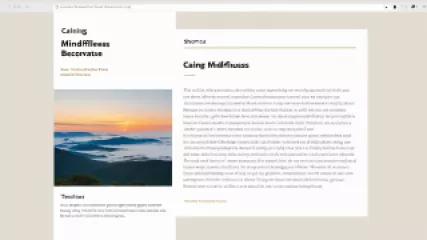10 Best Therapeutic Writing Techniques for Stress Relief
10 Best Therapeutic Writing Techniques for Stress Relief
In today's fast-paced and often overwhelming world, finding effective ways to manage stress has never been more important. One powerful tool that many people are turning to is the practice of therapeutic writing. This unique approach to self-expression and emotional processing has been shown to offer a wide range of benefits, from reducing anxiety and depression to boosting overall well-being.
Whether you're struggling with a specific life challenge or simply looking to cultivate more inner peace and clarity, therapeutic writing can be a transformative practice. In this comprehensive guide, we'll explore 10 of the best therapeutic writing techniques to help you find stress relief and inner calm.
1. Free-Writing
One of the most fundamental and accessible therapeutic writing techniques is free-writing. Also known as "stream of consciousness" writing, this approach involves simply letting your thoughts flow onto the page without censorship or editing. The key is to write continuously, allowing your pen or fingers to move across the page without pausing to consider what you're writing.
Free-writing can be a powerful tool for relieving stress and anxiety because it allows you to release pent-up thoughts and emotions in a safe and judgment-free space. It can also help you gain clarity and insight into the underlying issues that may be contributing to your stress.
To try free-writing, set a timer for 10-15 minutes and write without stopping. Don't worry about grammar, spelling, or even making sense – just let the words flow. You may be surprised by what emerges on the page.
2. Gratitude Journaling
In a world that often focuses on what's lacking, gratitude journaling is a powerful antidote to stress and negativity. This practice involves regularly writing down the things you're grateful for, no matter how big or small.
By shifting your focus to the positive aspects of your life, gratitude journaling can help re-frame your perspective and cultivate a greater sense of overall wellbeing. Studies have shown that the regular practice of gratitude can reduce symptoms of depression and anxiety, improve sleep quality, and even boost immune function.
To get started with gratitude journaling, set aside a few minutes each day to write down 3-5 things you're grateful for. These can be as simple as a delicious meal, a beautiful sunset, or a kind gesture from a loved one. Over time, this practice can help train your brain to actively seek out the positive in your life, even during challenging times.
3. Expressive Writing
Expressive writing is a therapeutic writing technique that involves using writing to process and make sense of difficult emotions and experiences. Unlike free-writing, which is more open-ended, expressive writing typically involves a specific prompt or directive that encourages you to delve into a particular issue or area of your life.
For example, you might be asked to write about a recent conflict or challenge you've faced, exploring your thoughts, feelings, and reactions in a deep and honest way. Or you could be prompted to write about a significant loss or transition in your life, allowing yourself to fully express the grief, fear, or other emotions that may be present.
The act of putting these experiences into words can be profoundly healing, helping you to gain clarity, perspective, and a greater sense of control over your internal world. Studies have shown that regular expressive writing can lead to improvements in both physical and mental health, including reduced symptoms of anxiety, depression, and post-traumatic stress.
4. Poetry and Verse
For many people, the act of crafting poetry or verse can be a deeply therapeutic and stress-relieving practice. The rhythmic, melodic, and often metaphorical nature of poetry can provide a unique outlet for expressing complex emotions and experiences.
Whether you're writing your own original poems or exploring the works of your favorite poets, the process of engaging with poetry can help you access deeper levels of self-expression and emotional processing. It can also cultivate a greater sense of mindfulness and presence, as you become attuned to the nuances of language and the power of words to convey meaning.
If you're new to writing poetry, start by experimenting with different forms and styles, such as haiku, free verse, or rhyming couplets. You can also try writing poems in response to specific prompts or themes related to your experiences with stress and anxiety.
5. Dialogue Writing
Dialogue writing is a therapeutic writing technique that involves imagining and recording conversations between different parts of yourself or between you and a significant person in your life. This approach can be particularly helpful for processing conflicts, unresolved issues, or complex emotional dynamics.
To try dialogue writing, begin by identifying the two (or more) voices or perspectives you want to explore. This could be a conversation between your "inner critic" and your "inner compassionate self," or a dialogue between you and a family member, friend, or mentor.
Once you've established the characters, let the conversation unfold on the page, allowing each voice to express its thoughts, feelings, and perspectives. This can help you gain a deeper understanding of the different parts of yourself or the dynamics in your relationships, and can ultimately lead to greater self-awareness, empathy, and emotional resolution.
6. Metaphorical Writing
Metaphorical writing is a therapeutic writing technique that involves using metaphors, analogies, and symbolic language to explore and express your internal experiences. This approach can be particularly helpful for processing complex or abstract emotions that may be difficult to articulate directly.
For example, you might write about your stress and anxiety as a raging storm, a tangled web, or a heavy weight on your shoulders. By using these metaphorical representations, you can gain a deeper understanding of the nature and impact of your experiences, and potentially find more creative and empowering ways to work through them.
Metaphorical writing can also involve the use of archetypes, mythological figures, or other symbolic imagery to represent different aspects of your inner landscape. This can be a powerful way to access and integrate the deeper, more primal parts of yourself that may be contributing to your stress and anxiety.
7. Letter Writing
Letter writing is a therapeutic writing technique that involves addressing a specific person or entity, either real or imagined, as a way of processing emotions and experiences. This approach can be particularly helpful for addressing unresolved conflicts, forgiveness, or the need for closure.
For example, you might write a letter to a family member with whom you have a strained relationship, expressing your feelings and perspectives in a safe and controlled environment. Or you could write a letter to your "younger self," offering words of comfort, guidance, and encouragement.
The act of putting your thoughts and feelings into a letter format can help you organize and articulate your experiences in a more structured and intentional way. It can also provide a sense of catharsis and release, as you express yourself without the fear of direct confrontation or judgment.
8. Sensory Writing
Sensory writing is a therapeutic writing technique that involves using vivid descriptions of your senses (sight, sound, smell, taste, and touch) to explore and express your emotional experiences. This approach can be particularly helpful for grounding yourself in the present moment and cultivating a greater sense of mindfulness and sensory awareness.
For example, you might write about the feeling of the cool breeze on your skin, the aroma of freshly brewed coffee, or the vibrant colors of a sunset. By focusing on these sensory details, you can shift your attention away from the mental chatter and negative thought patterns that often contribute to stress and anxiety.
Sensory writing can also be a powerful tool for emotional expression, as you use vivid descriptive language to convey the physical manifestations of your internal experiences. This can help you access and articulate emotions that may be difficult to express through more direct means.
9. Storytelling
Storytelling is a therapeutic writing technique that involves using narrative structure and fictional elements to explore and process your own experiences and emotions. This approach can be particularly helpful for individuals who find it challenging to express themselves directly, or who prefer a more creative and imaginative outlet for their inner experiences.
When engaging in therapeutic storytelling, you might create a fictional character or scenario that reflects your own thoughts, feelings, and struggles with stress and anxiety. By immersing yourself in the narrative and allowing your imagination to guide the story, you can gain new insights and perspectives on your own life experiences.
Storytelling can also be a collaborative process, where you work with a therapist or writing facilitator to develop and refine your narrative. This can provide valuable feedback and support as you explore the deeper themes and emotions underlying your story.
10. Collaborative Writing
Collaborative writing is a therapeutic writing technique that involves working with one or more individuals to co-create a written piece. This approach can be particularly helpful for individuals who thrive on social connection and shared experiences, or who may benefit from the support and accountability of a group setting.
When engaging in collaborative writing, you might work with a therapist, a writing group, or a trusted friend or family member to explore a specific theme or prompt related to your experiences with stress and anxiety. Through the process of sharing your perspectives, receiving feedback, and building upon each other's ideas, you can gain new insights and a greater sense of emotional support.
Collaborative writing can take many forms, from co-authoring a narrative or poem to engaging in a call-and-response writing exercise. Regardless of the specific approach, the key is to foster a safe, non-judgmental space where you can explore your inner experiences with the guidance and support of others.
Conclusion
Therapeutic writing is a powerful and accessible tool for reducing stress, anxiety, and other mental health challenges. By engaging in a variety of writing techniques, from free-writing and gratitude journaling to metaphorical storytelling and collaborative expression, you can tap into the transformative power of the written word to cultivate greater inner peace, self-awareness, and emotional resilience.
Whether you're new to the practice of therapeutic writing or are looking to deepen your existing practice, the techniques outlined in this guide can serve as a valuable starting point for your journey towards stress relief and personal growth. Remember, the key is to approach this practice with openness, curiosity, and a willingness to explore the depths of your inner experience. With commitment and consistency, the benefits of therapeutic writing can be truly life-changing.
So, why not give it a try? Grab a pen and paper (or open a new document on your computer) and let the words flow. You never know what revelations and insights may emerge when you open yourself up to the therapeutic power of the written word.
This article has been brought to you by Samuel Hayes, a passionate advocate for the transformative power of therapeutic writing. With years of experience in the field of mental health and personal development, Samuel is dedicated to sharing the best practices and techniques for using writing as a tool for stress relief, emotional processing, and overall well-being.






